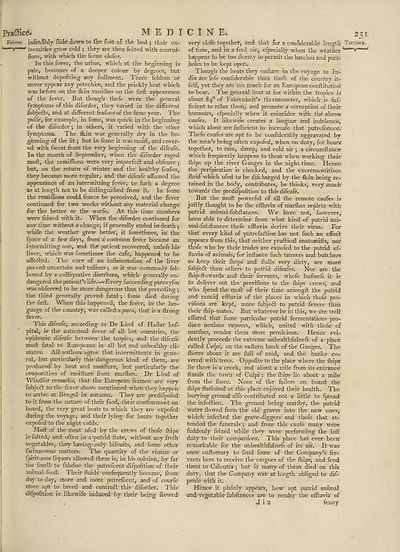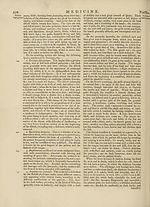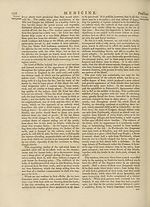Encyclopaedia Britannica, or, a Dictionary of arts, sciences, and miscellaneous literature : enlarged and improved. Illustrated with nearly six hundred engravings > Volume 13, MAT-MIC
(293) Page 251
Download files
Complete book:
Individual page:
Thumbnail gallery: Grid view | List view

Pra£Hc& M E D I
Febres. infehSbly flids down to tiro foot oF the bed 5 their ex-
l- * ' ' tFeraxties grow cold •, they are then feized with convol-
fions, with which the fcene elofes.
In this fever, the urine, which at the beginning is
pale, becomes of a deeper colour by degrees, but
without depofiting any fediment. There feldom or
never appear any petechiae, and the prickly heat which
was before on the Ikin vanilhes on the firft appearance
of the fever. But though thefe were the general
fymptoms of this diforder, they varied in the different
fubje&s, and at different feafonsof the fame year. The
pulfe, for example, in fome, was quick in the beginning
of the diforder; in others, it varied with the other
fymptoms. The fkin was generally dry in the be¬
ginning of the fit; but in fome it was moift, and cover¬
ed with fweat from the very beginning of the difeafe.
In the month of September, when the diforder raged
moft, the remiffions were very imperfect and obfeure ;
but, on the return of winter and the healthy feafon,
they became more regular, and the difeale affumed the
appearance of an intermitting fever, to fuch a degree
as at length not to be diftinguifhed from it. In fome
the remiflions could fcarce be perceived, and the fever
continued for two weeks without any material change
for the better or the worfo. At this time numbers
were ferzed with it. When the diforder continued for
any time without a change, it generally ended in death ;
white the weather grew better, it fometimes, in the
fpace of a few days, from a common fever became an
intermitting one, and the patient recovered, unlefs his
liver, which was fometimes the cafe, happened to be
affefted. The cure of an inflammation of the liver
proved uncertain and tedious ; as it was Commonly fol¬
lowed by a colliquative diarrhoea, which generally en¬
dangered the patient’s life.—'Every fucceeding paroxyfm
was obferved to be more dangerous than the preceding;
the third generally proved fatal; fome died during
the firft. When this happened, the fever, in the lan¬
guage of the country, -vVas called zpuca, that is a ftrong
fever.
This difeafe, according, to Dr Lind of Haflar hof-
pital, is the autumnal fever of all hot countries, the
epidemic difeafe between the tropics, and the difeafe
rtioft fatal to Europeans in all hot and unhealthy cli¬
mates. AH authors agree that intermittents in gene¬
ral, but particularly this dangerous kind of them, are
produced by heat and moifture, but particularly the
evaporation of moifture from marflies. Dr Lind of
Windfdr remarks, that the European feamen are very
fubjecl to the fever above mentioned when they happen
to arrive at Bengal in autumn. They are predifpofed
to it from the nature of their food, their confinement on
board, the very great heats to which they are expofed
during the voyage, and their lying for hours together
expofed to the night colds.
Moft of the meat ufed by the crews of tbofe fliips
is falted/ and often in a'putrid ftate, without any frefli
vegetables, they having, only bifeuits, and fome other
farinaceous matters. The quantity of the vinous or
fpirituous liquors allowed them is, in his opinion, by far
too fin all to fubdue the putrefeent difpofition of their
animal-food. 'I'heir fluids confequently become, from
day to day, more and more putrefoent, and of courfe
more apt to breed and contratt this diforder. This
■difpofition is likewife induced by their being flowed
CINE. 251
very clofe together, and that For a confidcrable length Tertiara.
of time, and in a foul air, efpeciaHy when the weather
happens to be too ftormy to permit the hatches and port¬
holes to be kept open.
Though the heats they endure in the voyage to In¬
dia are lefs confiderable than tbofe of the country it-
felf, yet they are too much for an European conftitution
to bear. The general heat at fea within the tropics is
about 84° of Fahrenheit’s thermometer, which is fuf-
ficient to relax them, and promote a corruption of their
humours, elpecially when it coincides with the above
caufes. It likewife creates a languor and indolence,
which alone are fufficicnt to increafe that putrefcence.
I hefe caufes are apt to be confiderably aggravated by
the men’s being often expofed, when on duty, for hours'
together, to rain, damp, and cold air ; a cireumftance
which frequently happens to them when working their
(hips up the river Ganges in the night-time. Hence
the perfpiration is checked, and the excrementitious
fluid which ufed to be difcharged by the fkin being re¬
tained in the body, contributes, he thinks, very much
towards the predifpofition to this difeafe.
But the moft powerful of all the remote caufes is
juftly thought to be the effluvia of marfhes replete with
putrid animal-fubftances. We have not, however,
been able to determine from what kind of putrid ani-
mal-fubftances thefe effluvia derive their virus. For
that every kind of putrefaction has not fuch an effect
appears from this, that neither praClical anatomifts, nor
thofe who by their trades are expofed to the putrid ef¬
fluvia of animals, for inftance fuch tanners and butchers
as keep their {hops and flails very dirty, are more
fubjeCt than others to putrid difeafes. Nor are the
fhip-ftewards and their fervants, whofe bufinefs it is
to deliver out the provifions to the fhips crews, and
who fpend the moft of their time amongft the putrid
and rancid effluvia of thn places in which thofe pro¬
vifions are kept, more fubjecl to putrid fevers than
their fhip-mates. But whatever be in this, we are well
affured that fome particular putrid fermentations pro¬
duce noxious vapours, which, united with thofe of
marflies, render them more pernicious. Hence evi¬
dently proceeds the extreme unhealtbfulnefs of a place
called Ct/lpt, on the eaftern bank of the Ganges. The
fhores about it are full of mud, and the banks co¬
vered with trees. Oppofite to the place where the fhips
lie there is a creek, and about a mile from its entrance
Hands the town of Culpi : the fhips lie about a mile
from the fhore. None of the feilors on board the
fhips flattened at this place enjoyed their health. The
burying ground alfo contributed not a little to fpread
the infeftion. The ground being marfliy, the putrid
water flowed from the old graves into the new ones,
which infeCted the grave-diggers and thofe that at¬
tended the funerals •, and from this caufe many were
fuddenly feized while they were performing the laft
duty to their companions. This place has ever been
remarkable for the unhealthfulnefs of its air. It was
once cuftomary to fend fome of the Company’s fer¬
vants here to receive the cargoes of the fhips, and fend
them to Calcutta ; but fo many of thCm died on this
duty, that the Company was at length obliged to dif-
penfe with it.
Hence it plainly appears, how apt putrid animal
and vegetable fubftances are to render the effluvia of
4 i 2 fenny
Febres. infehSbly flids down to tiro foot oF the bed 5 their ex-
l- * ' ' tFeraxties grow cold •, they are then feized with convol-
fions, with which the fcene elofes.
In this fever, the urine, which at the beginning is
pale, becomes of a deeper colour by degrees, but
without depofiting any fediment. There feldom or
never appear any petechiae, and the prickly heat which
was before on the Ikin vanilhes on the firft appearance
of the fever. But though thefe were the general
fymptoms of this diforder, they varied in the different
fubje&s, and at different feafonsof the fame year. The
pulfe, for example, in fome, was quick in the beginning
of the diforder; in others, it varied with the other
fymptoms. The fkin was generally dry in the be¬
ginning of the fit; but in fome it was moift, and cover¬
ed with fweat from the very beginning of the difeafe.
In the month of September, when the diforder raged
moft, the remiffions were very imperfect and obfeure ;
but, on the return of winter and the healthy feafon,
they became more regular, and the difeale affumed the
appearance of an intermitting fever, to fuch a degree
as at length not to be diftinguifhed from it. In fome
the remiflions could fcarce be perceived, and the fever
continued for two weeks without any material change
for the better or the worfo. At this time numbers
were ferzed with it. When the diforder continued for
any time without a change, it generally ended in death ;
white the weather grew better, it fometimes, in the
fpace of a few days, from a common fever became an
intermitting one, and the patient recovered, unlefs his
liver, which was fometimes the cafe, happened to be
affefted. The cure of an inflammation of the liver
proved uncertain and tedious ; as it was Commonly fol¬
lowed by a colliquative diarrhoea, which generally en¬
dangered the patient’s life.—'Every fucceeding paroxyfm
was obferved to be more dangerous than the preceding;
the third generally proved fatal; fome died during
the firft. When this happened, the fever, in the lan¬
guage of the country, -vVas called zpuca, that is a ftrong
fever.
This difeafe, according, to Dr Lind of Haflar hof-
pital, is the autumnal fever of all hot countries, the
epidemic difeafe between the tropics, and the difeafe
rtioft fatal to Europeans in all hot and unhealthy cli¬
mates. AH authors agree that intermittents in gene¬
ral, but particularly this dangerous kind of them, are
produced by heat and moifture, but particularly the
evaporation of moifture from marflies. Dr Lind of
Windfdr remarks, that the European feamen are very
fubjecl to the fever above mentioned when they happen
to arrive at Bengal in autumn. They are predifpofed
to it from the nature of their food, their confinement on
board, the very great heats to which they are expofed
during the voyage, and their lying for hours together
expofed to the night colds.
Moft of the meat ufed by the crews of tbofe fliips
is falted/ and often in a'putrid ftate, without any frefli
vegetables, they having, only bifeuits, and fome other
farinaceous matters. The quantity of the vinous or
fpirituous liquors allowed them is, in his opinion, by far
too fin all to fubdue the putrefeent difpofition of their
animal-food. 'I'heir fluids confequently become, from
day to day, more and more putrefoent, and of courfe
more apt to breed and contratt this diforder. This
■difpofition is likewife induced by their being flowed
CINE. 251
very clofe together, and that For a confidcrable length Tertiara.
of time, and in a foul air, efpeciaHy when the weather
happens to be too ftormy to permit the hatches and port¬
holes to be kept open.
Though the heats they endure in the voyage to In¬
dia are lefs confiderable than tbofe of the country it-
felf, yet they are too much for an European conftitution
to bear. The general heat at fea within the tropics is
about 84° of Fahrenheit’s thermometer, which is fuf-
ficient to relax them, and promote a corruption of their
humours, elpecially when it coincides with the above
caufes. It likewife creates a languor and indolence,
which alone are fufficicnt to increafe that putrefcence.
I hefe caufes are apt to be confiderably aggravated by
the men’s being often expofed, when on duty, for hours'
together, to rain, damp, and cold air ; a cireumftance
which frequently happens to them when working their
(hips up the river Ganges in the night-time. Hence
the perfpiration is checked, and the excrementitious
fluid which ufed to be difcharged by the fkin being re¬
tained in the body, contributes, he thinks, very much
towards the predifpofition to this difeafe.
But the moft powerful of all the remote caufes is
juftly thought to be the effluvia of marfhes replete with
putrid animal-fubftances. We have not, however,
been able to determine from what kind of putrid ani-
mal-fubftances thefe effluvia derive their virus. For
that every kind of putrefaction has not fuch an effect
appears from this, that neither praClical anatomifts, nor
thofe who by their trades are expofed to the putrid ef¬
fluvia of animals, for inftance fuch tanners and butchers
as keep their {hops and flails very dirty, are more
fubjeCt than others to putrid difeafes. Nor are the
fhip-ftewards and their fervants, whofe bufinefs it is
to deliver out the provifions to the fhips crews, and
who fpend the moft of their time amongft the putrid
and rancid effluvia of thn places in which thofe pro¬
vifions are kept, more fubjecl to putrid fevers than
their fhip-mates. But whatever be in this, we are well
affured that fome particular putrid fermentations pro¬
duce noxious vapours, which, united with thofe of
marflies, render them more pernicious. Hence evi¬
dently proceeds the extreme unhealtbfulnefs of a place
called Ct/lpt, on the eaftern bank of the Ganges. The
fhores about it are full of mud, and the banks co¬
vered with trees. Oppofite to the place where the fhips
lie there is a creek, and about a mile from its entrance
Hands the town of Culpi : the fhips lie about a mile
from the fhore. None of the feilors on board the
fhips flattened at this place enjoyed their health. The
burying ground alfo contributed not a little to fpread
the infeftion. The ground being marfliy, the putrid
water flowed from the old graves into the new ones,
which infeCted the grave-diggers and thofe that at¬
tended the funerals •, and from this caufe many were
fuddenly feized while they were performing the laft
duty to their companions. This place has ever been
remarkable for the unhealthfulnefs of its air. It was
once cuftomary to fend fome of the Company’s fer¬
vants here to receive the cargoes of the fhips, and fend
them to Calcutta ; but fo many of thCm died on this
duty, that the Company was at length obliged to dif-
penfe with it.
Hence it plainly appears, how apt putrid animal
and vegetable fubftances are to render the effluvia of
4 i 2 fenny
Set display mode to:
![]() Universal Viewer |
Universal Viewer | ![]() Mirador |
Large image | Transcription
Mirador |
Large image | Transcription
Images and transcriptions on this page, including medium image downloads, may be used under the Creative Commons Attribution 4.0 International Licence unless otherwise stated. ![]()
| Permanent URL | https://digital.nls.uk/192664971 |
|---|
| Attribution and copyright: |
|
|---|
| Description | Ten editions of 'Encyclopaedia Britannica', issued from 1768-1903, in 231 volumes. Originally issued in 100 weekly parts (3 volumes) between 1768 and 1771 by publishers: Colin Macfarquhar and Andrew Bell (Edinburgh); editor: William Smellie: engraver: Andrew Bell. Expanded editions in the 19th century featured more volumes and contributions from leading experts in their fields. Managed and published in Edinburgh up to the 9th edition (25 volumes, from 1875-1889); the 10th edition (1902-1903) re-issued the 9th edition, with 11 supplementary volumes. |
|---|---|
| Additional NLS resources: |
|

